Many ST1100 owners find that extra lights enhance night riding safety. Among the hazards are nocturnal animals (DEER!!!!!!). The most popular addition for this is a set of PIAA® 910 driving lights, mounted below the mirrors using a set of brackets engineered by the late Ron Major.
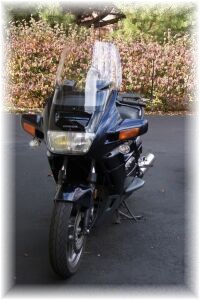 I've devised a similar arrangement for mounting Hella® Optilux® 1500 driving lamps. These use 55 watt H3 bulbs, and have a wider light pattern than the PIAAs. Hence I find them good for hilly, curvy roads ridden at legal speeds, with no oncoming traffic. These lights have glass lenses that measure about 3" wide by 2.5" high, with die cast metal housings and steel brackets painted gloss black. I picked them up at classicgarage.com on sale for only $25 plus about $7 shipping. (Note: I have no connection with any of the companies mentioned herein.) I made up some parts to mount them below the mirrors.
I've devised a similar arrangement for mounting Hella® Optilux® 1500 driving lamps. These use 55 watt H3 bulbs, and have a wider light pattern than the PIAAs. Hence I find them good for hilly, curvy roads ridden at legal speeds, with no oncoming traffic. These lights have glass lenses that measure about 3" wide by 2.5" high, with die cast metal housings and steel brackets painted gloss black. I picked them up at classicgarage.com on sale for only $25 plus about $7 shipping. (Note: I have no connection with any of the companies mentioned herein.) I made up some parts to mount them below the mirrors.
Here's the bill of material: one piece 3/4" square extruded aluminum 1/16" thick at least 2.5 inches in length; one piece 2" by 2" extruded aluminum angle, 1/8" thick, same length; two bolts, 6 by 50mm; two bolts, 6 by 12mm (Phillips or internal hex or Torx drive); two flatwashers, 6 mm inside diameter; two nuts, 6 mm; Epoxy cement; Black spray paint. I found the aluminum stock and 50mm long bolts at Home Depot. The nuts and the short bolts were some unused battery terminal fasteners that I already had.
After you have made your new brackets, you'll find that the mirror covers must be notched to clear them. But it's tough to know where each notch should be located, because there are only soft contours on the bike to try to measure from. Now's the time to put a piece of masking tape across the seam between the mirror cover and the fairing about in line with the lower mirror cover mounting snap fastener. Cut the tape where it crosses the seam. After you have mounted your new brackets, you can measure from the edge of the tape back to the bracket, and know how far from the tape on the mirror cover to position the notch.
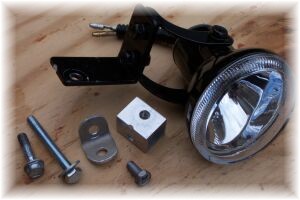

Cut a piece of the square tube a little less than 1" long. This part will fit up into the lower recess of the mirror bracket. A small notch must be filed in one of the corners midway along its length to clear a small rib in the mirror (see pictures). Mark the hole location for the mirror mounting bolt. After drilling through both sides of the spacer, temporarily bolt the spacer to the mirror and mark the hole location in the spacer's upper face. This will use the 6x12mm bolt through the hole in the mirror bracket that the mirror cover retainer strap originally used. Put a small amount of epoxy on the nut to retain it and install the 12mm long bolts. You will see why a recess drive bolt is required here, because there's no wrench clearance.
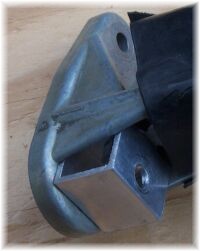
The aluminum angle is used for the light mount. Cut a 1" length for each. Drill a hole centered 1/4" from the forward edge and 3/8" down from the top edge. This locates the bracket far enough rearward so that trimming the mirror cover doesn't remove any significant structure. Temporarily mount the mirrors and brackets to the bike. Note that the mount top edge contacts a rib on the mirror. Mark this location on the mount. Progressively file a notch in the mount at this location to enable the mount to end up vertical in the side view (see pictures). This allows you to get proper mount alignment despite not having a machine shop at your disposal.
I shortened the horizontal leg of the mount by 1/4" to match the width of the Hella brackets. After drilling the two mounting holes in each, file all the corners and edges round and paint them gloss black.
The last part you have to fabricate is the small angle piece to provide an anchor spot for the mirror cover retainer strap. This part is 3/4" wide with 3/4" legs. I made mine from small bits of scrap aluminun I had on hand, but a piece of the square tube could be cut for this purpose. Drill one hole to fit the upper mirror mounting bolt (6mm). The hole for the retainer should be 5/16" diameter. This bracket is mounted in conjuction with the upper mirror mounting bolt. Use the ST's original 6 by 25mm bolt here.
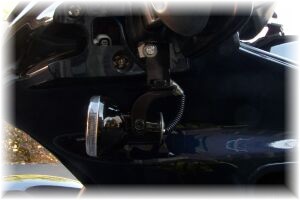

Now is the time to notch the mirror covers to clear the new brackets. Measure on the bike the distance from the masking tape to the edges of the bracket. Then mark the mirror covers according to those measurements. Use a saw, file, or Dremel® tool to make your notches.
Now you're all set to wire up the bike. The light kit includes a relay, wiring harness, switch and a wiring diagram. I used the high beam indicator lamp wire to provide the signal through the switch to the relay. After installing another double throw switch and going through a lot of agony figuring out how to make the lights selectively work either on high beam only or on all the time, I decided that "high-beam only" is the way to go. I should have used the switch provided with the light kit. I mounted my switch in the left hand fairing pocket panel, a couple of inches above the little inspection plate. Before you decide on a location, make sure there's clearance behind the panel for the switch body.
The wires to each light fit through the gap between the bracket and the upper fairing, so the notch in the mirror cover automatically accomodates them. I added a short piece of convoluted black wire loom, visible in the above right picture, to cover the blue and white wires coming from the rear of the lights.
The brackets are rigid enough for the small lights I installed. They would not be satisfactory for much larger, heavier ones, because there's only one bolt holding each of them to the bike.
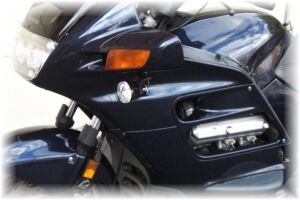
Last updated on January 28, 2014
© 2002-2014 M. E. Martin, All rights reserved
 I've devised a similar arrangement for mounting Hella® Optilux® 1500 driving lamps. These use 55 watt H3 bulbs, and have a wider light pattern than the PIAAs. Hence I find them good for hilly, curvy roads ridden at legal speeds, with no oncoming traffic. These lights have glass lenses that measure about 3" wide by 2.5" high, with die cast metal housings and steel brackets painted gloss black. I picked them up at classicgarage.com on sale for only $25 plus about $7 shipping. (Note: I have no connection with any of the companies mentioned herein.) I made up some parts to mount them below the mirrors.
I've devised a similar arrangement for mounting Hella® Optilux® 1500 driving lamps. These use 55 watt H3 bulbs, and have a wider light pattern than the PIAAs. Hence I find them good for hilly, curvy roads ridden at legal speeds, with no oncoming traffic. These lights have glass lenses that measure about 3" wide by 2.5" high, with die cast metal housings and steel brackets painted gloss black. I picked them up at classicgarage.com on sale for only $25 plus about $7 shipping. (Note: I have no connection with any of the companies mentioned herein.) I made up some parts to mount them below the mirrors.




